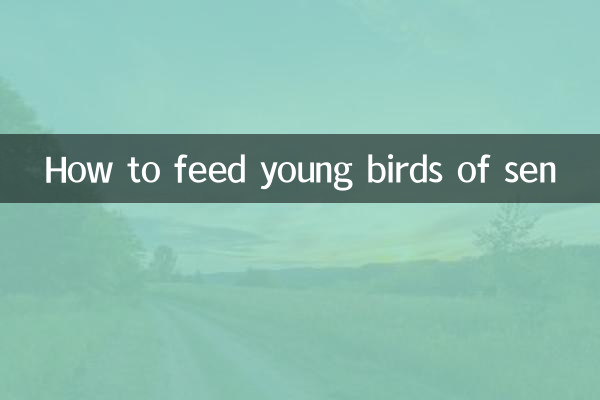How to feed young birds of sen
Brother Wu is a smart bird that is loved by bird friends. Feeding young senile birds requires mastering scientific methods to ensure their healthy growth. The following are detailed guides on feeding young birds of seniles, including structured data such as diet, environment, and precautions.
1. Dietary needs of young birds

The diet of young birds of senile should be mainly high in protein and easy to digest, and the feeding methods are slightly different at different stages. Here are the dietary suggestions for young birds:
| Age group | Recommended food | Feeding frequency |
|---|---|---|
| 0-7 days | Special baby bird milk powder, diluted egg yolk liquid | Once every 2 hours |
| 8-14 days | Milk powder + a small amount of pureed fruit (such as apples, bananas) | Once every 3 hours |
| 15-30 days | Soft food (such as soft bird food and cooked millet) | Once every 4 hours |
| More than 1 month | Grained bird food, fresh fruits and vegetables, insects (such as pedantic insects) | 3-4 times a day |
2. Feeding tools and methods
Feeding young wool birds requires the use of the right tools and mastering the correct feeding skills:
| tool | use | Things to note |
|---|---|---|
| Small syringe | Feed liquid food | Avoid bolus too fast and prevent choking |
| Soft spoon | Feed semi-liquid food | Be gentle to avoid injury to the bird's beak |
| Insulation box | Maintain the temperature of young birds | The temperature is controlled at 28-32℃ |
III. Environmental and sanitation management
The young birds of senile have high environmental requirements and should pay attention to the following points:
| Environmental factors | Require |
|---|---|
| temperature | 25-30℃ (need to be higher during the young bird period) |
| humidity | 50%-70% |
| illumination | Avoid direct sunlight and provide soft light |
| health | Clean food basins and water basins daily and disinfect bird cages regularly |
4. Frequently Asked Questions and Solutions
During the feeding of the young wool birds, you may encounter the following problems:
| question | reason | Solution |
|---|---|---|
| Refusal to eat | The temperature is too low and the food is not up to taste | Adjust the ambient temperature and replace the food |
| diarrhea | Food is not fresh or overdose | Suspend feeding, provide warm water, and seek medical treatment if necessary |
| Fluffy feathers | Insufficient body temperature or illness | Check insulation measures and observe other symptoms |
5. Health checks and growth observations
Regularly check the health of young birds to ensure their normal development:
| Check items | Health standards |
|---|---|
| weight | Daily growth of 1-2 grams (young bird stage) |
| stool | Forming, no abnormal smell |
| Mental state | Lively and responsive |
6. Summary
Feeding young wool birds requires patience and care. Every step from diet, environment to health management is crucial. Through scientific feeding, young birds can grow up healthily and become a smart and lively senile in the future. If you encounter problems that cannot be solved, it is recommended to consult a professional veterinarian or bird breeding expert in time.

check the details

check the details